Google Nexus 9: Preliminary Findings
by Joshua Ho on November 3, 2014 1:00 PM ESTCPU Performance
While there’s a great deal of ground to cover on the tablet as a whole, one of the most interesting aspects of the Nexus 9 is the SoC. While we’ve tested Tegra K1 before, we were looking at the more traditional Cortex A15 variant. The Denver variant (Tegra13x) is mostly similar to Tegra K1-32 (Tegra12x), but instead the CPU cores are a radically different design. In order to get an idea for how this translates into real world we can look at a few of our standard benchmarks in this area, although Google Octane couldn’t complete a full run. This build of Android clearly has AArch64 active, which means that we should be able to directly compare the Nexus 9 to the iPad Air 2 for performance.
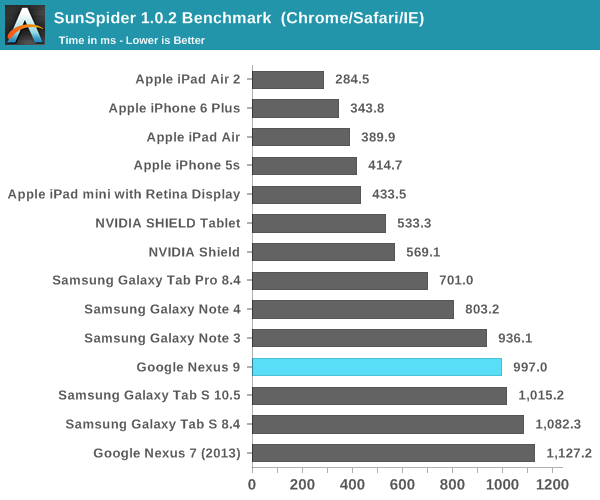
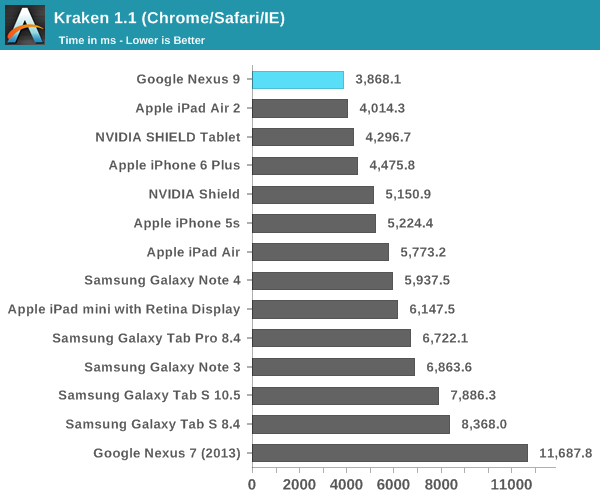

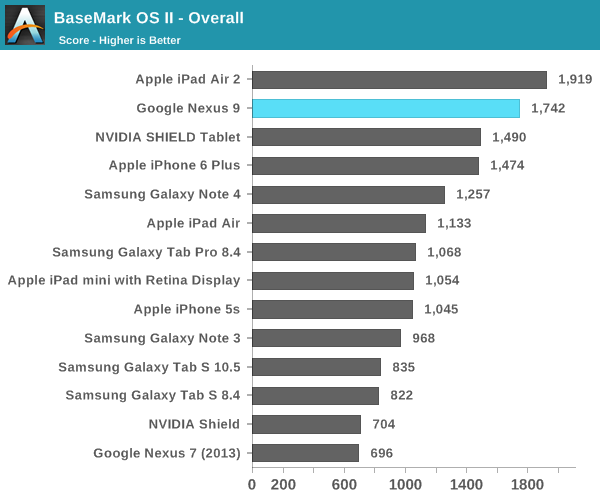
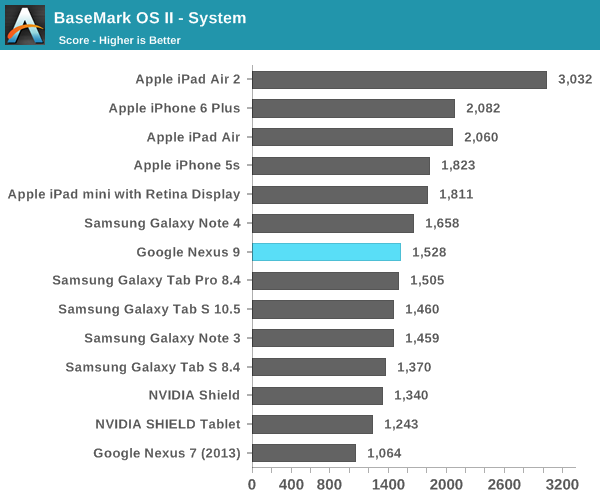
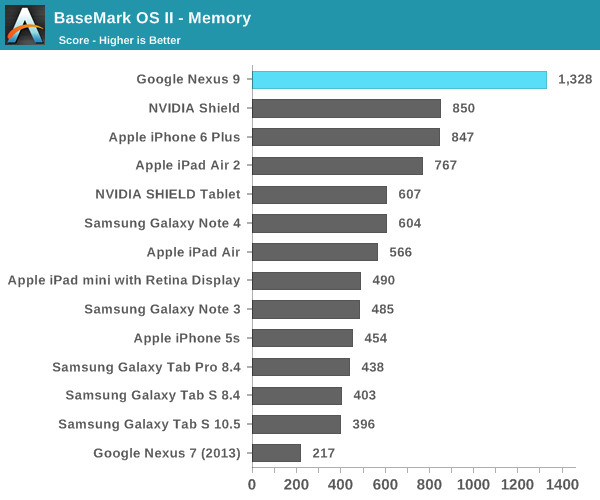
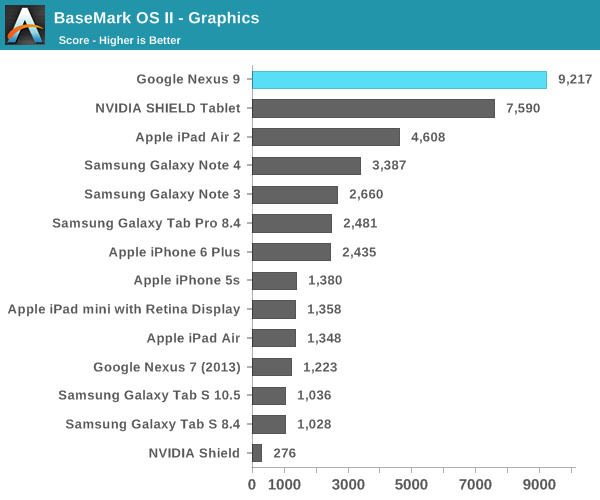
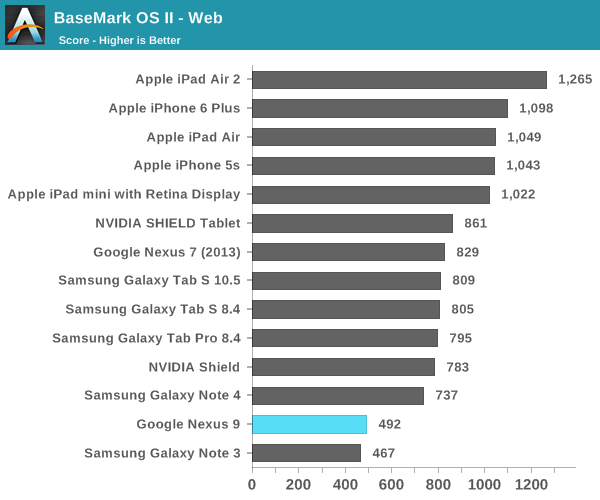
As one can see, at least at this stage in development the Nexus 9 can show some level of promise at times, but can be a bit disappointing in others. In SunSpider, Denver is generally even slower than Krait. However, in a benchmark like Kraken the Nexus 9 easily pulls ahead to take the top spot. In Basemark OS II the Nexus 9 does well overall but this seems to be due to its graphics performance/GPU performance and storage performance rather than CPU-bound tests like the system and web tests. It seems that when the code morphing systems works as expected, Denver can deliver significant amounts of performance. However, when such code morphing falls flat its true performance with a dual core, 2.3 GHz configuration is around that of a four Krait core CPU system at similar clock speeds. Once again, it's important to emphasize that this build is far from complete so performance should improve across the board with launch software. The fact that Tegra13x can approach A8X in CPU performance in some tests is definitely interesting to see.
Battery Life
While Denver's performance is a bit mixed, it's worth taking a look at battery life to see how Denver performs in these areas. As always, our battery life tests are all run with the display calibrated to 200 nits.
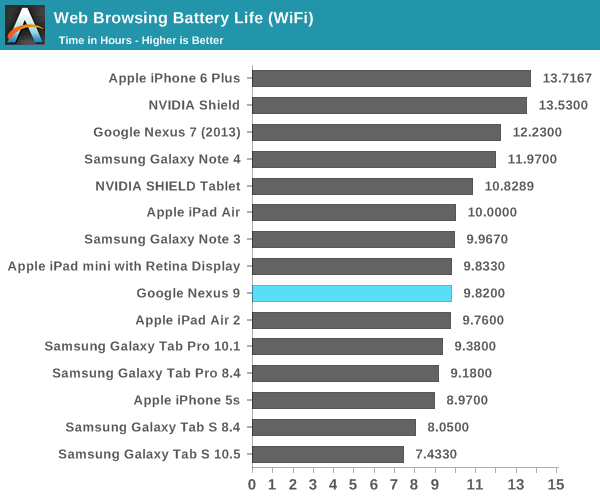
While an early build, it seems that the Nexus 9 is reasonably competitive in battery life but I'm not sure that these results are perfectly accurate. At any rate, efficiency at this stage seems to be par for the course, which should bode well for shipping software. This is a mostly display-bound test though, so we'll look at Basemark OS II to get a better idea for compute-bound battery life.
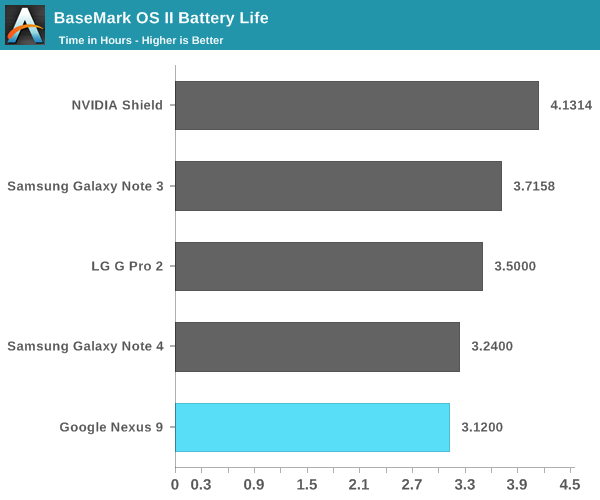

As one can see, while the battery life of the Nexus 9 ends up on the bottom for phablets and tablets, the overall performance during the test is quite high. We're working on a better comparison for the final review, but this should give a good idea of what to expect in general.










146 Comments
View All Comments
jhenzie - Tuesday, November 11, 2014 - link
Final compilation has always been on device and ART can consume Dexfrostyfiredude - Monday, November 3, 2014 - link
ART bytecode most certainly IS optimized for 64-bit assuming they didn't throw in native methods or odd languages. "Apps built in Java will automatically gain these benefits, with no changes to existing code. Apps built on other languages, built with the Android NDK r10b [0], can compile for 64-bit architectures to access the features listed above." https://plus.google.com/u/0/+AndroidDevelopers/pos...buttdill - Tuesday, November 4, 2014 - link
ART compiles java bytecode to the appropriate native bytecode: it should generate AArch64 instructions if the hardware supports it. The java bytecode is platform-independent so it doesn't care about AArch64, so purely Java apps don't need to do anything special to be 64-bit, just be run by a 64-bit interpreter.And while there is no Dalvik, there is still native code: these are the apps which don't "run purely on ART bytecode". This native code has to be recompiled by the developers to include AArch64 insruction set.
Zarsus - Wednesday, November 5, 2014 - link
ART will compile any non-native Android app to 64-bit when viable just as Java VM will compile any java code to 64-bit when viable.What makes you think ART doesn't do that when it makes sense anyway?
Samus - Monday, November 3, 2014 - link
Well yeah, but how many Apple apps are 64-bit? How many Windows apps?Apple is going to have the short-term advantage in just a few months, though, as they are requiring their devs to publish 64-bit versions of apps when they update them after February...
I think the timeframe Apple is giving is a little aggressive, but commendable. Google should consider doing the same thing, but because of the way Play Store works (no screening) I doubt they will.
darwinosx - Monday, November 3, 2014 - link
Apple has been 64 bit for a year and ART is still a runtime. Many iOS apps are 64 bit and they are complied for the shot part.kron123456789 - Monday, November 3, 2014 - link
"Well yeah, but how many Apple apps are 64-bit?" — I think almost all of them. All the benchmarks, at least.noelbonner - Tuesday, November 11, 2014 - link
There are a number of tablets that are higher ranked in CONSUMER BASED rankings (like http://is.gd/yWOP3B for example).craighamilton - Saturday, December 6, 2014 - link
Not a big fan of Nexus 9... there are plenty of tablets that have higher user satisfaction(see http://www.topreport.org/tablets/ for example...)
chizow - Monday, November 3, 2014 - link
How so? That's exactly the point, Apple had the opportunity to go with a significantly bigger battery with their larger screen size but didn't, in fact the battery on the Air 2 is smaller than the Air 1. We also know for a fact it is harder to get bigger batteries into devices the smaller they get, and large tablets can scale battery much higher due to size/surface area.